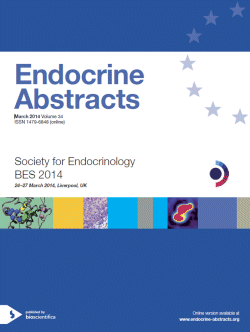Searchable abstracts of presentations at key conferences in endocrinology
Symposia
Some like it hot ‐ new insights into brown adipose tissue
ea0034s11.1 | Some like it hot ‐ new insights into brown adipose tissue | SFEBES2014
Molecular regulation of brown and beige fat cell fate
Seale Patrick , Wang Wenshan , Rajakumari Sona , Harms Matthew
Brown adipocytes in dedicated depots of brown adipose tissue (BAT) arise from cellular precursors that also give rise to skeletal muscle cells. We found that early B cell factor-2 (Ebf2) expression in the mesoderm of mouse embryos marks brown fat precursors that are destined to activate Pparγ expression and differentiate into Ucp1+ brown adipocytes. Loss of Ebf2 in mice causes a very severe defect in BAT development and function. Ebf2 cooperates with Pparγ t...
ea0034s11.2 | Some like it hot ‐ new insights into brown adipose tissue | SFEBES2014
The metabolic capacities of brown adipose tissue
In rodents, brown adipose tissue is known to be a metabolically highly active organ. This concerns rates of blood flow, capacity for oxygen consumption and rates of uptake of lipid and carbohydrate substrates. The high rates of metabolism are dependent on stimulation of the tissue by norepinephrine, released from sympathetic neurons innervating the tissue. Following stimulation, thermogenesis occurs as a result of activation of the uncoupling protein UCP1 in the inner membrane...
ea0034s11.3 | Some like it hot ‐ new insights into brown adipose tissue | SFEBES2014
How brown is human BAT?
Brown adipose tissue (BAT) was previously thought of as an animal-only tissue. Recently, this view was radically changed by several publications suggesting that active BAT might be part of normal human physiology. These results together with other papers on the same topic, make BAT-mediated dissipation of excess energy in humans a real possibility. Together, these advances are stimulating a radical reassessment of the role of brown adipose tissue in human pathophysiology. Furt...




